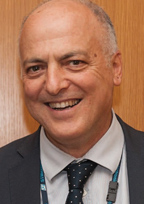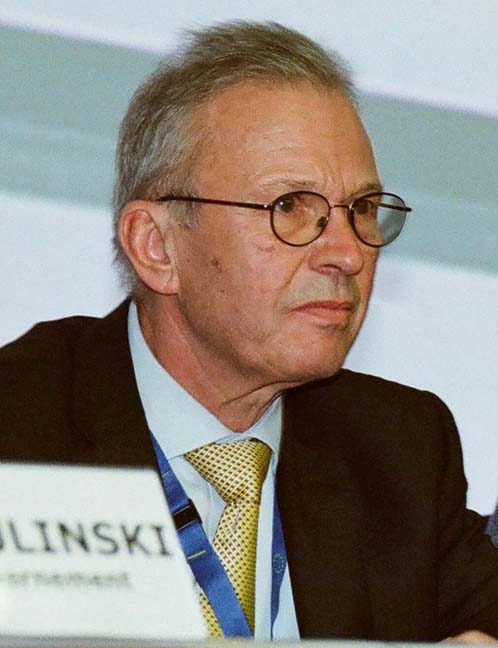 Bernhard Richter, Leica Geosystems GNSS business director
Bernhard Richter, Leica Geosystems GNSS business director Enrico Salvatori, Qualcomm Europe
Enrico Salvatori, Qualcomm Europe Carlo Bagnoli, STMicroelectronics
Carlo Bagnoli, STMicroelectronicsCarlo Bagnoli is Director of Infotainment BU System and Applications at STMicroelectronics. The company is a global semiconductor leader focusing on smart driving and the internet of things, creating intelligent and energy-efficient products that enable intelligent transport as well as smarter factories, cities and homes.
Within the infotainment business unit, Bagnoli and his team work to develop positioning receivers, broadcast receivers and communication processors for the automotive market. Doing so means gathering GNSS signals from far and wide.
Carlo Bagnoli is Director of Infotainment BU System and Applications at STMicroelectronics. The company is a global semiconductor leader focusing on smart driving and the internet of things, creating intelligent and energy-efficient products that enable intelligent transport as well as smarter factories, cities and homes.
Within the infotainment business unit, Bagnoli and his team work to develop positioning receivers, broadcast receivers and communication processors for the automotive market. Doing so means gathering GNSS signals from far and wide.
Once upon a time, Bagnoli says, “everybody thought GPS was enough. Now it’s the multi-constellation system that is a sort of de facto requirement.”
Coming Up
Early believers in the power of multiconstellation in situations such as urban canyons STMicroelectronics beat all major competitors to the punch when it unveiled its dual-constellation, GPS+Glonass receiver in 2011. But in fact the company had already been working for years on blending GPS+Galileo signals.
“We started in 2004 with some high-level exploratory work,” Bagnoli explained, “ and then we did our first funded research under the European Union’s FP7 Program, working to develop a Galileo-ready positioning terminal. Based on the outcome of that research we created the navigation CPU CartesioPlus product.”
So Galileo was already present in ST’s GPS/GNSS receiver hardware by the mid-2000s, with a new RF and an FPGA-based baseband. A production version of CartesioPlus followed in high volume from 2009, but it was in reality still a GPS-only chipset, because there were not yet any operational Galileo satellites in orbit.
“We were still looking into increasing the number of supporting constellations,” Bagnoli said, “So with Galileo still under development, we began working on a new product that could also support Glonass, called ‘Teseo’, which we completed and launched in 2011.”
By then, he said, the rest of the mobile industry had already understood that Glonass was quite relevant for improving the user experience in urban canyons. However, he said, the rest of the automotive mission-critical industry was late: “With Teseo, putting together the first multi-constellation chip, we anticipated the work of the others by 12-24 months.”
Today, Bagnoli says, the accuracy of Glonass has improved, through better geometry, but not because of the accuracy of the actual signal, which is still a problem.
Galileo is Born
For STMicroelectronics, the launch of Galileo initial services in December 2016 was a real breakthrough, Bagnoli said: “For a GNSS receiver company, the birth of any new Open Service GNSS system has to be considered an opportunity for new integration as it improves the user experience with no major steady-state cost added.”
The case for Galileo, he said, was a no-brainer. “ST decided to include Galileo from its inception and we have had it both in our CartesioPlus navigation CPUs and in our dedicated standalone Teseo receivers. And we are completely committed to including it on our next-generation multi-band precise positioning platforms.
“With Galileo there is no major cost of development; the development applies to multiple system-on-chip platforms, so the relative effort of adding Galileo to a set of already -supported constellations is very manageable.”
Bagnoli said the his company definitely made the right decision in preparing for Galileo early: “ST is focused on automotive and ITS and in these markets research and development cycles take significant time. Thanks to foresight, we now have two mature product families and we are looking forward to the business development of our Galileo-capable receivers.”
Multi, Multi, Multi…
Everyone seems to agree; a new type of mission-critical GNSS receiver is now needed, one that can work in conjunction with correction data available from multiple sources, ultimately providing sub-meter accuracy.
To this end, Bagnoli said, STMicroelectronics is looking at ways to combine all the functional GNSS constellations: “Finally, as we have more and more automotive ITS, integrity is becoming more and more important, so redundancy is useful and, for example, cooperative multi-constellation anti-spoofing is something that we have already worked on.
“We now have a solution where we do very fine monitoring of the different systems in order to provide more integrity beyond the accuracy dimension, and this is going to be particularly relevant for regulated services and so on.”
Indeed, while these single- frequency, multi-constellation GNSS solutions are still viable for traditional Infotainment applications, emerging intelligent transportation systems (ITS) and liability- and safety-critical applications such as advanced driver assistance systems (ADAS) are raising performance and integrity requirements for GNSS receivers, creating demand for new and even more advanced GNSS solutions.
Bagnoli describes the clear advantages of a rapidly maturing Galileo system in terms of its high accuracy and high integrity, the latter of which he says has been an overlooked aspect in many markets. “If your aim is to increase accuracy, augmenting GPS through a multi-constellation configuration, then Galileo is really the best way to go, particularly for automotive and ITS systems; And its integrity features will serve well in support of regulated services.
“Right now, with Beidou3 still under construction, GPS+Galileo is going to be a very solid mode, and this is the only harmonized pure L1 receiver combination available.”
Again, Bagnoli says, for his company the key market for the Galileo open service is ITS, including liability- and safety-critical applications. “STMicroelectronics is focusing to this market and aiming to be a key player there,” he said. “Further, we expect that this will become a multi-frequency as well as a multi-constellation equation, as more augmented driving applications arrive, and we are excited by the challenge and the business opportunity.”





